Abstract
Driven by the global energy transition and the dual carbon goals, developing low-carbon and zero-carbon alternative fuels has become a core issue for sustainable development in the internal combustion engine sector. Ammonia is a promising zero-carbon fuel with broad application prospects. However, its inherent combustion characteristics, including slow flame propagation, high ignition energy, and narrow flammable range, limit its use in internal combustion engines, necessitating the addition of auxiliary fuels. To address this issue, this paper proposes a composite injection technology combining “ammonia duct injection + hydrogen cylinder direct injection.” This technology utilizes highly reactive hydrogen to promote ammonia combustion, compensating for ammonia’s shortcomings and enabling efficient and smooth engine operation. This study, based on bench testing, investigated the effects of hydrogen direct injection timing (180, 170, 160, 150, 140°, 130, 120 °CA BTDC), hydrogen direct injection pressure (4, 5, 6, 7, 8 MPa) on the combustion and emissions of the ammonia–hydrogen engine. Under hydrogen direct injection timing and hydrogen direct injection pressure conditions, the hydrogen mixture ratios are 10%, 20%, 30%, 40%, and 50%, respectively. Test results indicate that hydrogen injection timing that is too early or too late prevents the formation of an optimal hydrogen layered state within the cylinder, leading to prolonged flame development period and CA10-90. The peak HRR also exhibits a trend of first increasing and then decreasing as the hydrogen direct injection timing is delayed. Increasing the hydrogen direct injection pressure to 8 MPa enhances the initial kinetic energy of the hydrogen jet, intensifies the gas flow within the cylinder, and shortens the CA0-10 and CA10-90, respectively. Under five different hydrogen direct injection ratios, the CA10-90 is shortened by 9.71%, 11.44%, 13.29%, 9.09%, and 13.42%, respectively, improving the combustion stability of the ammonia–hydrogen engine.
1. Introduction
As the global demand for reducing greenhouse gas emissions and addressing climate change grows increasingly urgent, developing clean, efficient energy technologies to replace traditional fossil fuels has become a top priority. Ammonia, as a potential carbon-neutral fuel, has garnered significant attention in recent years due to its high hydrogen content, ease of liquefaction for storage and transportation, and the absence of carbon dioxide in its combustion products [1]. However, ammonia’s low flame speed, high autoignition temperature, and narrow ignition limit pose challenges for its application in internal combustion engines. Hydrogen, as a clean and efficient fuel with high flame propagation speed and a wide flammable limit, has already achieved relatively mature applications in the field of internal combustion engines. Introducing hydrogen into ammonia–hydrogen blended fuels can improve combustion, broaden their ignition limits, enhance combustion efficiency, and reduce emissions of pollutants such as particulate matter and nitrogen oxides [2]. Therefore, ammonia–hydrogen blended fuels are considered a promising transitional solution in the internal combustion engine field, enabling a gradual transition toward low-carbon fuels based on existing internal combustion engine technology.
Li’s research analyzed the effects of hydrogen blending ratio and equivalence ratio on combustion and emissions in an ammonia/hydrogen rotary engine through experiments and numerical simulations. The results indicate that ignition is difficult when the hydrogen blending ratio is below 20%, but combustion performance significantly improves when it exceeds 20%. The peak CP and HRR increase with the blending ratio. NO production increases with the blending ratio in the initial stage but decreases after reaching a peak at high blending ratios. An increase in the equivalence ratio leads to higher CP, but when the equivalence ratio exceeds 1.1, incomplete combustion results in reduced heat release and NO production [3]. Wang’s research investigated the impact of the ammonia/hydrogen mixture ratio on engine combustion and emission performance within an intake temperature range of 476 K to 551 K. The experiments showed that at an intake temperature of 476 K and a hydrogen mixture ratio of 30%, the engine power and performance reached their optimal levels, ammonia slip was eliminated, and emission performance was optimized [4]. Yu’s research proposes a reaction kinetics mechanism suitable for high-pressure engines to investigate the effects of hydrogen blending ratios on the ignition characteristics and engine performance of ammonia–hydrogen fuels. The study found that the addition of hydrogen significantly reduced the ignition delay time and autoignition temperature limits of the ammonia–hydrogen fuel mixture and altered the sensitive reaction pathways. In spark-ignition engines, increasing the hydrogen blending ratio enhances peak CP but requires delaying the ignition timing to optimize the combustion phase. Additionally, increasing the hydrogen blending ratio also increases NOx emissions [5].
Yu’s research employed a composite injection mode combining direct hydrogen injection with ammonia port injection to investigate the impact of hydrogen mixture ratios on the combustion and emission characteristics of ammonia/hydrogen composite injection engines. Experimental results indicate that as the hydrogen mixture ratio increases, the IMEP rises, the combustion process shortens, and temperature and pressure increase. When the hydrogen mixture ratio reaches 27.3%, the engine achieves optimal overall performance. NOx emissions increase with the hydrogen mixture ratio, while NH3 emissions decrease [6]. Ji’s research evaluated the performance and emissions of hydrogen/ammonia/air-premixed fuels in spark ignition engines. Under specific conditions, adding 2.2% ammonia compared to pure hydrogen prolonged ignition delay and flame development time, and reduced pressure rise rate, but had little effect on engine performance. The addition of ammonia increased nitrogen oxide emissions, indicating its potential as a combustion inhibitor [7]. Xin investigated the effects of ammonia–hydrogen fuel on engine performance under different mixture ratios and excess air ratios. The results showed that under theoretical air–fuel ratio conditions, increasing the ammonia proportion significantly improved the engine’s brake mean effective pressure and BTE (brake thermal efficiency), but had a smaller effect under lean burn conditions. Ammonia–hydrogen engines have lower exhaust temperatures and require a small inertial turbocharger. When the ammonia volume ratio exceeds 80%, engine operational stability decreases. Additionally, the ammonia–hydrogen fuel mixture leads to increased NOx emission [8]. Ji’s research used numerical simulation to investigate the effects of high compression ratios and ignition timing on the performance of ammonia–hydrogen engines. The results showed that as the compression ratio increased, there was a trade-off between turbulence dissipation rate and turbulent kinetic energy, heat transfer losses increased, and flow velocity and turbulence intensity first increased and then decreased. High compression ratios improve ignition stability, shorten combustion time, reduce cooling losses, and enhance output power, but NOx emissions also increase. By adjusting ignition timing, combustion performance can be optimized at high compression ratios, with the maximum IMEP and indicated thermal efficiency reaching 4 bar and 38.3%, respectively [9]. Hong’s research focused on ammonia/hydrogen dual-fuel engines and proposed four load control strategies: ammonia volume fraction (AVF), qualitative control, quantitative control, and intake variable valve timing (VVT) adjustment, and evaluated their applicability. The Miller cycle was introduced to enhance performance. Experimental results showed that under different AVF conditions, the BTE of the engine has been improved. Qualitative control and intake VVT adjustment effectively expanded the BMEP adjustment range and maintained BTE above 37% under most operating conditions. The quantitative control strategy performed poorly [10].
Sharma investigated hydrogen enrichment combustion technology in dual-fuel diesel engines, analyzing the effects of different injection methods on engine performance and emissions. The study found that optimizing hydrogen injection timing and exhaust gas recirculation can reduce NOx emissions and enhance combustion stability. The paper also highlights current research limitations and future development directions, guiding the application of hydrogen in internal combustion engines [11]. Hydrogen internal combustion engines offer high efficiency and environmental benefits, but face challenges such as reduced volumetric efficiency, high NOx emissions, and backfiring in intake manifold injection applications. Backfiring represents the most severe challenge, potentially causing engine performance degradation or even damage. Khalid investigated strategies to control backfiring by optimizing hydrogen fuel injection systems, specifically focusing on injection pressure, timing, and duration. He emphasized that future research should focus on how these optimizations impact combustion, performance, and emissions, enabling the technology’s application through minor adjustments [12]. Akhtar’s study compared three hydrogen injection methods in diesel engines. Liquid hydrogen blended fuel maintained engine power and efficiency; intake manifold and direct injection reduced power but significantly lowered emissions, with intake manifold injection achieving the best emission reduction. Liquid hydrogen fuel offered the best balance between performance and efficiency, while the other two methods prioritized emission reduction [13]. Aboujafari’s research investigated the effects of different gas additives on ammonia–hydrogen dual-fuel engines through numerical simulations. Results indicate that simultaneously injecting nitrogen or argon during ammonia injection effectively reduces NO and NO2 emissions without compromising engine performance. Conversely, adding carbon dioxide and oxygen negatively impacts emissions and pressure [14].
Currently, research on the combustion and emission characteristics of ammonia–hydrogen engines has primarily focused on optimizing the mixture ratio and engine parameters [11,12,13]. However, systematic studies on the effects of hydrogen injection strategies on the combustion and emissions of ammonia–hydrogen engines remain relatively scarce. In ammonia–hydrogen engines, hydrogen injection strategies have a critical impact on the formation of the mixture, the combustion process, and the final emission performance. Different injection strategies, such as premixed injection, direct injection into the cylinder, directly affect the proportion and uniform distribution of the ammonia–hydrogen mixture, as well as the initiation and duration of combustion. Optimizing hydrogen injection strategies is key to achieving efficient and clean combustion in ammonia–hydrogen engines. In particular, the detailed combustion mechanisms, pollutant formation, and their interrelationships under different injection strategies still require further in-depth exploration. Therefore, this thesis aims to conduct an in-depth study on the effects of hydrogen injection strategies on the combustion and emissions of ammonia–hydrogen engines. Through experimental research methods, the following aspects will be focused on: the influence of different injection strategies on the combustion and emission characteristics of ammonia–hydrogen engines. By comparing the advantages and disadvantages of these strategies, we aim to explore optimized injection strategies that achieve efficient and clean combustion in ammonia–hydrogen engines.
2. Test Methods
2.1. Engine Test Platform
The principle diagram of the ammonia/hydrogen engine test platform is shown in Figure 1. The test was conducted on a 1.91 L four-stroke, inline, water-cooled engine with a compression ratio of 9.6 and a bore and stroke of 80 mm and 92 mm, respectively. The engine is equipped with two independent fuel injection systems. One is the ammonia low-pressure injection system, which injects gaseous ammonia fuel into the intake manifold. The injection pressure is set to 0.3 MPa, as the ammonia flow meter achieves the highest accuracy at this operating pressure. The injection pressure is regulated by a pressure-reducing valve in the supply line. The other system is a hydrogen high-pressure injection system, which directly injects hydrogen fuel into the engine cylinders. The peak hydrogen injection pressure is 10 MPa, and the injection pressure is regulated by a pressure-regulating valve in the fuel supply pipeline. The emission analyzer is a MEXA-7100DEGR HORIBA, the combustion analyzer is the 6260 model produced by AVL of Austria, the dynamometer is the CW440 model eddy current dynamometer produced by Nanfeng Machinery Factory of China, the ammonia flow meter is the AIROBOOST G-AB-13 model gas mass flow controller, and the hydrogen flow meter is the Emerson CMF010P model mass flow meter [14]. The instrument used to measure ammonia emissions in the test is the ECM 5241 NOx/NH3 Analyzer from the United States.
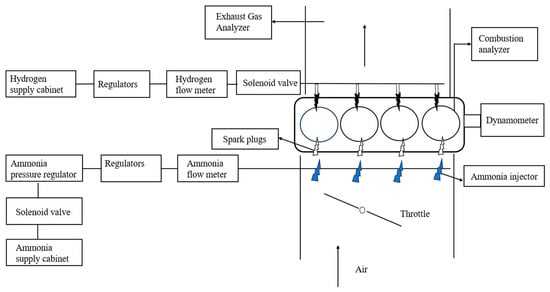
Figure 1.
Schematic diagram.
2.2. Fuel and Experiment Method
Table 1 chemical properties of the ammonia–hydrogen fuel used in the experiment. To ensure the repeatability and comparability of the test data, five tests were repeated during the test, the highest and lowest values were removed, and the average value was calculated for the remaining values.

Table 1.
Characteristics of the fuel.
2.3. Definition of Test-Related Parameters
Hydrogen blending ratio (HBR): In this study, the hydrogen blending ratio is defined as the energy ratio, i.e., the ratio of the heat released by the hydrogen injected into the cylinder per cycle to the total heat released by the fuel (hydrogen and ammonia) in the cylinder per cycle.
where qH2 and qNH3 represent the heat released by hydrogen and ammonia injected into the cylinder per cycle, respectively; Hu(H2) and Hu(NH3) represent the lower heating values of hydrogen and ammonia, respectively; MH2 and MNH3 denote the mass of hydrogen and ammonia injected into the cylinder per cycle, respectively.
COVIMEP: When a spark-ignition internal combustion engine operates stably under certain conditions, the combustion process varies between consecutive cycles. This phenomenon is referred to as combustion cycle variation in spark-ignition internal combustion engines. It is primarily manifested in-cylinder pressure curves, engine power output, and flame propagation. Since cylinder pressure is relatively easy to measure, this study uses IMEP to characterize the cycle variation coefficient [16].
3. Analysis of Results
3.1. Hydrogen Injection Timing
3.1.1. MBT
To prevent intake manifold backfiring, all hydrogen direct injection timing points are set after 180 °CA BTDC. This section uses MBT as the ignition timing for the corresponding operating conditions. Table 2 shows the specific test plan.

Table 2.
Test plan.
Figure 2 shows the variation in the optimal ignition advance angle with the hydrogen direct injection timing under different hydrogen direct injection ratios. Results indicate that, on one hand, delaying the hydrogen direct injection timing shortens the mixing time between hydrogen and air. This reduced mixing time may create more pronounced concentration gradients within the cylinder, where hydrogen becomes more concentrated in certain regions. Due to the decreased mixing time, the formation of a mixture suitable for ignition occurs relatively later [17]. Delaying the ignition advance angle at this point improves the isochoric efficiency of the combustion process, leading to higher torque output. On the other hand, as the hydrogen injection ratio increases, the optimal ignition advance angle shifts backward.
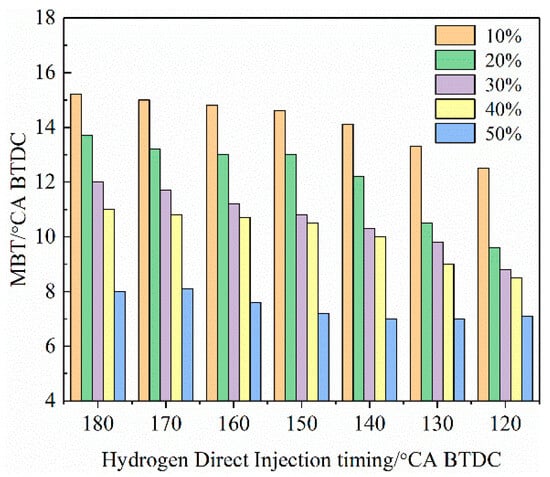
Figure 2.
Effect of hydrogen direct injection timing on MBT.
3.1.2. CA0-10 and CA10-90
In this paper, the definitions of CA0-10 and CA10-90 can be found in References [18,19]. Figure 3a illustrates the variation of the CA0-10 with hydrogen direct injection timing under different hydrogen direct injection ratios. The results indicate that, across all hydrogen injection ratios, CA0-10 initially decreases and then increases as injection is delayed. This behavior may be attributed to early injection leading to excessive hydrogen diffusion and mixture inhomogeneity [20], whereas late injection can result in local hydrogen enrichment and oxygen deficiency, both of which extend the flame development period [21]. Furthermore, as the hydrogen direct injection ratio increases, CA0-10 gradually shortens. This reduction is accompanied by a retarded optimal ignition timing, and the higher in-cylinder temperature and pressure at the time of ignition promote the formation of a stable flame kernel, further contributing to the shortening of CA0-10.
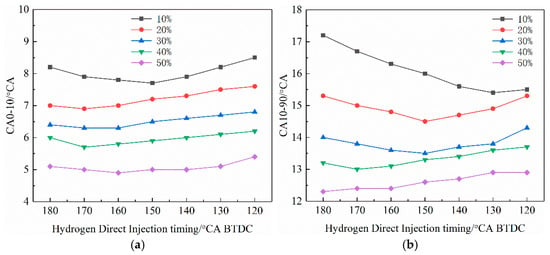
Figure 3.
Effect of hydrogen direct injection timing on the (a) CA0-10 and (b) CA10-90.
Figure 3b shows the variation of CA10-90 with hydrogen direct injection timing under different hydrogen injection ratios. The results reveal that at hydrogen injection ratios between 10% and 40%, CA10-90 initially decreases and then increases as injection is delayed. At a 10% hydrogen ratio, both excessively early and late injection timings cause uneven hydrogen distribution, which prolongs CA0-10 and consequently increases CA10-90 [22]. For hydrogen ratios ranging from 20% to 40%, hydrogen is more widely distributed in the cylinder. However, overly advanced or retarded injection still extends CA0-10 and slows the initial expansion of the flame front toward the cylinder wall, ultimately leading to a longer CA10-90. In contrast, at the high injection ratio of 50%, hydrogen supply is sufficient and flame development is rapid. Under these conditions, CA10-90 continues to shorten as injection timing is advanced. This trend is further reinforced by the higher hydrogen ratio itself, which accelerates the rapid combustion phase, along with the shift in optimal ignition timing [23].
3.1.3. Peak CP and Peak HRR
Figure 4a shows the variation in the peak HRR with the timing of hydrogen direct injection under different hydrogen direct injection ratios. The results show that, under different hydrogen direct injection ratios, the peak HRR exhibits a trend of first increasing and then decreasing as the injection timing is advanced. When the hydrogen injection timing is overly advanced, it leads to difficulties in forming the flame core, low initial combustion velocity, and an extended CA10-90. Additionally, the worsening of isochoric combustion caused by premature ignition timing further reduces the peak HRR. When the hydrogen direct injection timing is too delayed, hydrogen accumulation near the spark plug and insufficient oxygen supply prolong the rapid combustion phase and disperse the heat release process, also leading to a decrease in the peak [24]. Additionally, as the hydrogen direct injection ratio increases, the peak HRR generally shows an upward trend, which is attributed to the optimal ignition timing being closer to the top dead center, thereby improving the combustion isochoric process and facilitating an increase in the peak HRR [25].
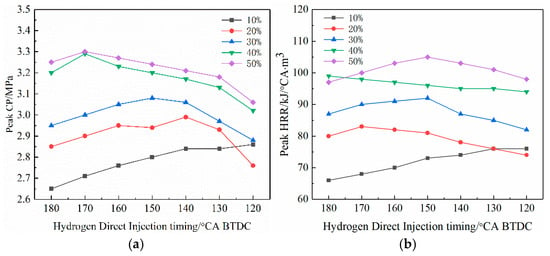
Figure 4.
Effect of hydrogen direct injection timing on the (a) peak CP and (b) peak HRR.
Figure 4b shows the trend of peak CP with injection time. Experimental results indicate that at hydrogen injection ratios between 20% and 50%, delaying the injection timing causes the peak cylinder pressure to exhibit a completely opposite variation pattern compared to the 10% ratio. At this point, the amount of hydrogen in the cylinder is relatively high, effectively aiding in the formation of a stable flame core. Hydrogen direct injection that occurs too early results in uniform hydrogen distribution and slow combustion, leading to a reduction in peak pressure. Conversely, an injection that occurs too late causes hydrogen enrichment, which prolongs the combustion period and thereby reduces peak CP [26]. When the injection ratio is 10%, delaying the direct injection timing can significantly increase the peak CP. The mechanism behind this is that the local enrichment of hydrogen promotes rapid combustion. At the same time, the optimal ignition angle shift optimizes the combustion phase. In addition, increasing the hydrogen ratio can further increase the peak CP, mainly due to improvements in the isochoric combustion [27].
3.1.4. COVIMEP
Figure 5 illustrates the variation in engine cycle performance as a function of hydrogen injection timing under different hydrogen injection ratios. The results indicate that, regardless of the hydrogen injection ratio, as the hydrogen injection timing is delayed, the engine cycle performance exhibits a trend of first decreasing and then increasing. When the hydrogen injection timing is advanced, the hydrogen distribution within the cylinder becomes more homogeneous. At ignition, the hydrogen concentration near the spark plug, as well as the cylinder temperature and pressure, are relatively low, leading to an extended flame development period and increased uncertainty in flame propagation speed and direction, thereby causing an increase in engine cycle fluctuations. When the hydrogen direct injection timing is delayed, a large amount of hydrogen that has not fully diffused accumulates near the spark plug, increasing the compositional differences between the spark plug electrodes, which in turn increases the cycle variations during the early flame center formation process [28]. As the proportion of direct hydrogen injection increases, the variations in the engine cycle gradually decrease.
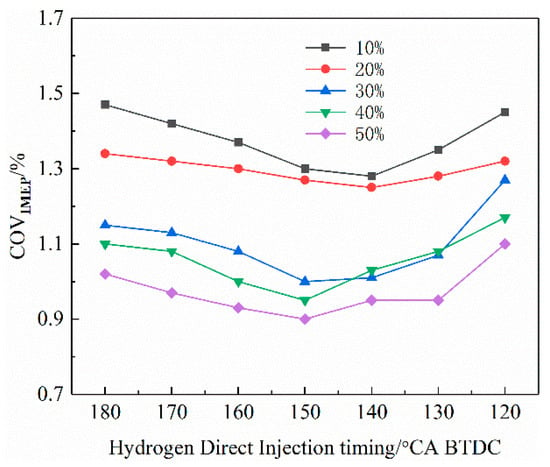
Figure 5.
Effect of hydrogen direct injection timing on COVIMEP.
3.1.5. NOx and NH3
Figure 6a illustrates the variation in NOx emissions with hydrogen direct injection timing under different hydrogen injection ratios. Results show that across all hydrogen ratios, NOx emissions initially increase and subsequently decrease as injection timing is delayed. Early hydrogen injection advances the optimal ignition angle, resulting in lower in-cylinder temperature and pressure at the moment of ignition. This condition slows flame kernel development and reduces flame propagation speed, leading to lower overall combustion temperatures and a narrower high-temperature region, thereby suppressing NOx formation [29]. Under delayed injection conditions, flame kernel formation remains slow and irregular, while flame propagation speed and directional variability increase. The prolonged combustion duration causes a portion of the ammonia–hydrogen mixture to burn during the expansion stroke, with some fuel remaining only partially oxidized. This incomplete combustion process, along with decreased in-cylinder temperatures and a constricted high-temperature zone, contributes to the inhibition of thermal NOx generation. Additionally, the presence of unburned NH3 may promote NOx reduction through chemical reactions, further reducing emissions. Moreover, as the hydrogen injection ratio increases, NOx emissions exhibit a non-monotonic trend [30]. Figure 6b shows the variation in NH3 emissions with the timing of hydrogen direct injection at different hydrogen direct injection ratios. NH3 emissions decrease initially and then increase as the hydrogen direct injection timing is delayed, in contrast to NOx. When the hydrogen direct injection timing is too early, the hydrogen mixes thoroughly. It burns at high temperatures with abundant oxygen, inhibiting NH3 formation. When the hydrogen direct injection timing is too late, uneven mixing creates low-temperature areas with abundant fuel, promoting NH3 formation. This complementary relationship stems from the fact that NH3 requires a reducing environment, while NOx requires an oxidizing environment.
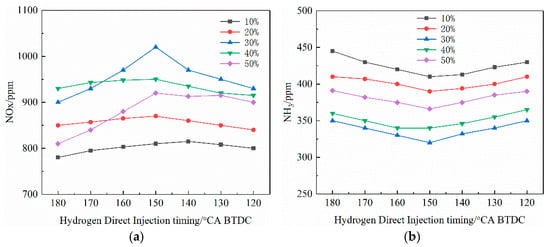
Figure 6.
Effect of hydrogen direct injection timing on (a) NOx and (b) NH3.
3.2. Hydrogen Injection Pressure
3.2.1. MBT
MBT is selected as the ignition timing for the corresponding operating conditions in this section. Table 3 shows the specific test plan.

Table 3.
Test plan.
Figure 7 shows the variation in the optimal ignition advance angle with hydrogen direct injection pressure under different hydrogen direct injection ratios. The results indicate that, on the one hand, under any hydrogen direct injection ratio, as the hydrogen direct injection pressure increases, the optimal ignition advance angle is delayed. The increase in hydrogen direct injection pressure intensifies the strength of the cylinder gas flow, further enhancing the turbulence intensity within the cylinder and accelerating the combustion rate [31]. At this point, delaying the ignition advance angle can increase the isochoric combustion process, resulting in superior torque output. On the other hand, as the hydrogen direct injection ratio increases, the corresponding optimal ignition advance angle shifts backward.
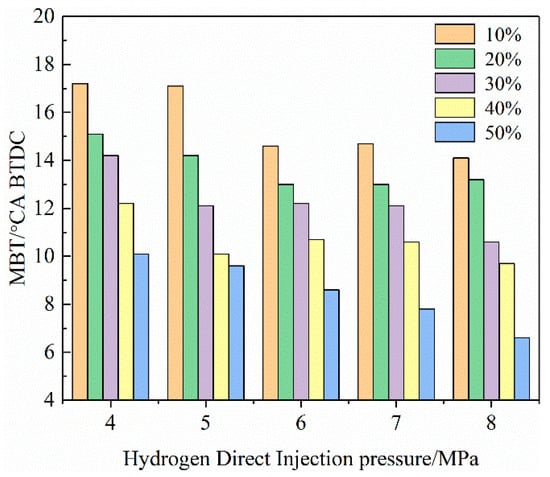
Figure 7.
Effect of hydrogen direct injection pressure on MBT.
Figure 8a shows the variation in the CA0-10 with hydrogen direct injection pressure under different hydrogen direct injection ratios. The results indicate that when the hydrogen direct injection ratio ranges from 10% to 40%, the CA0-10 initially decreases and then increases with an increase in hydrogen direct injection pressure. At lower injection pressures, weaker turbulence intensity may affect the quality of mixture formation; at higher pressures, enhanced mixing may alter the concentration distribution of the mixture around the spark plug, while stronger turbulence conditions may exert a certain influence on the initial development of the flame [32]. When the hydrogen ratio reaches 50%, the CA0-10 continues to decrease with increasing pressure, attributed to the high hydrogen concentration offsetting the negative effects of turbulence, and the delayed optimal ignition advance angle promoting combustion. Additionally, as the hydrogen direct injection ratio increases, the CA0-10 gradually shortens. At this point, the corresponding optimal ignition advance angle is delayed, further promoting the shortening of the CA0-10.
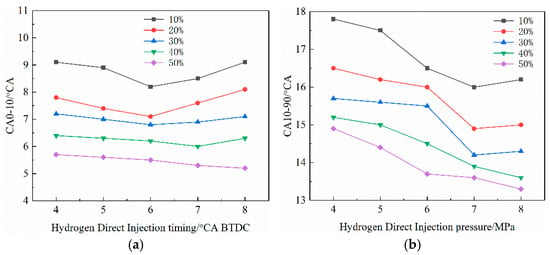
Figure 8.
Effect of hydrogen direct injection pressure on the (a) CA0-10 and (b) CA10-90.
Figure 8b illustrates the variation of CA10-90 with hydrogen direct injection pressure. At hydrogen injection ratios between 10% and 30%, CA10-90 initially decreases and then increases with rising injection pressure, reaching a minimum at 7 MPa. In contrast, at ratios of 40% to 50%, CA10-90 continuously shortens as injection pressure increases. At lower injection pressures, reduced hydrogen jet momentum weakens in-cylinder flow intensity, prolonging CA10-90. For injection ratios of 10–30%, excessively high pressure slows flame kernel formation and initial flame front expansion. Although higher injection pressure intensifies in-cylinder flow, its effect on accelerating flame propagation remains limited, ultimately extending the rapid combustion phase. At a 40% hydrogen ratio, elevated injection pressure effectively mitigates the slow initial flame propagation observed in early combustion, thus shortening the rapid combustion phase [33]. At 50%, further pressure increases enhance in-cylinder flow intensity and flame speed, leading to a consistent reduction in CA10-90. Additionally, higher hydrogen injection ratios generally shorten CA10-90. This reduction is accompanied by a retardation of the optimal ignition timing, which further promotes faster combustion.
3.2.2. Peak CP and Peak HRR
Figure 9a presents the variation of peak heat release rate (HRR) with hydrogen direct injection pressure. At hydrogen injection ratios of 40–50%, the peak HRR increases continuously with injection pressure. In contrast, at ratios of 10–30%, it first rises and then falls, attaining a maximum at 7 MPa. Peak HRR is strongly influenced by the rapid combustion phase. At higher hydrogen ratios (40–50%), increased injection pressure enhances the initial kinetic energy of the hydrogen jet and intensifies in-cylinder flow. This shortens the flame propagation time from the kernel to the walls and expands the flame front area per unit crank angle, concentrating heat release and raising the peak HRR [34]. Between 4 MPa and 8 MPa, the peak HRR increases by 14.47% and 7.44%, respectively. At lower hydrogen ratios (10–30%), raising injection pressure from 4 MPa to 7 MPa shortens the rapid combustion phase and concentrates heat release, increasing peak HRR. However, at 8 MPa, over-homogenized hydrogen distribution and intensified flow near the spark plug electrodes slow ignition and reduce flame speed. This extends the rapid combustion phase and disperses heat release, ultimately lowering the peak HRR [35]. Additionally, higher hydrogen injection ratios generally lead to a gradual increase in peak HRR.
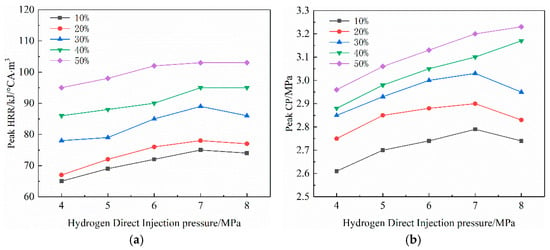
Figure 9.
Effect of hydrogen direct injection pressure on the (a) peak CP and (b) peak HRR.
Figure 9b shows the variation in peak CP with hydrogen direct injection pressure. It can be observed that when the hydrogen direct injection ratio is between 40% and 50%, both the cylinder pressure peak and the increase occur as the hydrogen direct injection pressure increases. This is because the increase in hydrogen direct injection pressure enhances the initial kinetic energy of the hydrogen jet and the intensity of gas flow movement within the cylinder, thereby generating high-quality turbulence inside the cylinder and accelerating the flame propagation speed. At this point, the optimal ignition advance angle shifts backward, increasing the isochoric degree of the combustion process and ultimately leading to an increase in the peak cylinder pressure. When the hydrogen direct injection ratio is between 10% and 30%, the peak cylinder pressure is achieved at 7 MPa. This is because when the hydrogen direct injection pressure rises to 8 MPa, the initial kinetic energy of the hydrogen jet becomes too high, and the intensity of the gas flow becomes too strong, making it difficult for the flame nucleus to form, resulting in a deterioration of the isochoric degree of the combustion process and an increase in combustion duration. On the other hand, as the hydrogen direct injection ratio increases, the peak CP gradually increases [36].
3.2.3. COVIMEP
Figure 10 illustrates the variation in engine cycle fluctuations with hydrogen direct injection pressure under different hydrogen injection ratios. The results show that cycle fluctuations initially decrease and then increase with rising injection pressure at hydrogen ratios of 10–20%, whereas they decline continuously at ratios of 30–50%. At low injection pressures, weak in-cylinder flow and low jet kinetic energy result in poor mixture homogeneity and significant compositional variation near the spark plug. Advanced ignition timing further reduces in-cylinder temperature and pressure at ignition, impairing ignition stability and increasing cycle fluctuations during flame initiation. Excessively high injection pressure intensifies in-cylinder flow, which can interfere with flame kernel formation but also accelerates flame propagation. At hydrogen ratios of 10–20%, the disruptive effect of strong flow on flame kernel stability outweighs its benefit to flame speed, increasing cycle fluctuations. In contrast, at ratios of 30–50%, the enhancement in flame propagation dominates, thereby reducing cycle fluctuations. Additionally, higher hydrogen injection ratios generally lead to a gradual reduction in cycle fluctuations.
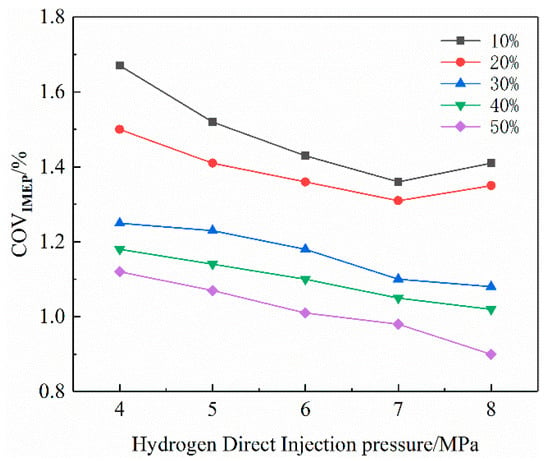
Figure 10.
Effect of hydrogen direct injection pressure on COVIMEP.
Figure 11a illustrates the variation of NOx emissions with hydrogen direct injection pressure under different hydrogen injection ratios. Results indicate that NOx emissions generally increase with injection pressure. This trend is attributed to the higher initial kinetic energy of the hydrogen jet at elevated pressures, which intensifies in-cylinder flow and turbulence. As a result, hydrogen disperses more rapidly throughout the chamber, including near-wall and crevice regions. The associated reduction in quenching layer thickness mitigates wall quenching and crevice effects, enabling more complete combustion. The consequent rise in combustion temperature promotes thermal NOx formation. A retarded ignition timing also contributes, as it leads to higher cylinder pressure and temperature at ignition, further favoring NOx production. Additionally, as the hydrogen injection ratio increases, NOx emissions exhibit a non-monotonic trend. Figure 11b shows changes in NH3 emissions with hydrogen direct injection pressure. NH3 emissions generally decrease with increasing injection pressure, primarily due to improved hydrogen atomization and mixing. This reduces local fuel-rich zones and promotes more complete combustion. The high-temperature environment under high-pressure conditions further suppresses NH3 formation by favoring NOx production. Consequently, NH3 emissions maintain an overall declining trend.
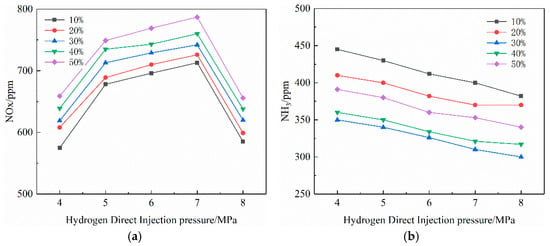
Figure 11.
Effect of hydrogen direct injection pressure on (a) NOx and (b) NH3.
4. Conclusions
The ammonia–hydrogen engine, as a novel zero-carbon propulsion system, has emerged as a key technological pathway for advancing the sustainable development of internal combustion engines. The advantages of renewable fuel and carbon-free combustion make it a vital contributor to achieving global climate goals, building a clean and low-carbon energy system, and promoting sustainable economic and social development. This paper investigates the effects of hydrogen direct injection strategies (hydrogen direct injection timing, and injection pressure) on the combustion and emission characteristics of ammonia–hydrogen engines using bench testing. The main findings are as follows:
(1) Hydrogen direct injection timing affects the diffusion time of hydrogen in the cylinder, thereby influencing the distribution of hydrogen at the ignition timing and ultimately affecting the entire combustion process. As the hydrogen injection timing is delayed, the flame development period exhibits a trend of first decreasing and then increasing. Both too early or too late injection timing leads to an increase in the CA0-10 and CA10-90. The peak HRR shows a trend of first increasing and then decreasing as the hydrogen injection timing is delayed. Cyclic fluctuations decrease first and then increase as the hydrogen direct injection timing is advanced. NOx emissions increase first and then decrease as the hydrogen direct injection timing is delayed. NH3 shows a trend of first decreasing and then increasing as the timing of hydrogen injection is delayed.
(2) Hydrogen direct injection pressure affects the initial kinetic energy of the hydrogen jet entering the cylinder, altering the gas flow dynamics within the cylinder and resulting in different hydrogen distribution states within the cylinder at the ignition timing. Appropriately increasing the hydrogen direct injection pressure can enhance the gas flow movement within the cylinder, shorten the flame development phase and rapid combustion phase of the combustion process, and reduce the combustion cycle variation of the engine. The optimal value of the direct injection pressure is influenced by the hydrogen direct injection ratio. Moderately increasing the hydrogen direct injection pressure can increase the peak HRR and peak CP. As the hydrogen direct injection pressure increases, NOx emissions gradually rise, NH3 emissions are gradually decreasing.
(3) Proposing a composite injection strategy of “ammonia intake duct injection + hydrogen cylinder direct injection,” this approach leverages hydrogen’s high reactivity (rapid flame propagation, low ignition energy) to compensate for the combustion deficiencies of ammonia fuel (slow flame propagation, difficult ignition), while avoiding the abnormal combustion risks associated with pure hydrogen internal combustion engines. This enables efficient and stable combustion of zero-carbon fuels, providing new insights into the application of ammonia/hydrogen mixed fuels in internal combustion engines.
Author Contributions
K.S.: Methodology, Software, Writing—original manuscript. H.W.: Visualization. All authors commented on the manuscript. All authors have read and agreed to the published version of the manuscript.
Funding
This work was supported by the Hubei University of Automotive Technology Doctoral Research Start-up Fund Project (BK202507).
Institutional Review Board Statement
Not applicable.
Informed Consent Statement
Not applicable.
Data Availability Statement
The data that support the findings of this study are available from the corresponding author upon reasonable request.
Conflicts of Interest
The authors declare that they have no known competing financial interests or personal relationships that could have appeared to influence the work reported in this paper.
Abbreviations
The following abbreviations are used in this manuscript:
| MBT | minimum advance for best torque |
| COV | coefficient of variations |
| CA0-10 | flame development period |
| CA10-90 | rapid combustion period |
| IMEP | indicated mean effective pressure |
| HRR | heat release rate |
| CP | cylinder pressure |
References
- Sun, X.; Jiang, Y.C.; Zhao, P.; Jing, G.; Ma, T. Effect of ammonia/hydrogen blending and injection modes on combustion emission and performance of marine engine. Fuel 2024, 371, 131894. [Google Scholar] [CrossRef]
- Sun, Y.; Yang, J.; Wang, S.; Zhang, Y. Ammonia-hydrogen direct injection in a rotary engine: A pathway to cleaner combustion. Energy 2025, 324, 135968. [Google Scholar] [CrossRef]
- Li, P.Z.; Pan, J.; Fan, B.; Qin, M.; Nauman, M.; Yang, W. Effects of injection timing and rotating speed on combustion and emissions in an Ammonia/Hydrogen rotary engine. Appl. Therm. Eng. 2025, 262, 125172. [Google Scholar] [CrossRef]
- Wang, B.; Wang, H.; Duan, B.; Yang, C.; Hu, D.; Wang, Y. Effect of ammonia/hydrogen mixture ratio on engine combustion and emission performance at different inlet temperatures. Energy 2023, 272, 127110. [Google Scholar] [CrossRef]
- Yu, Z.; Zhao, J.; Markov, V.; Han, D. Effects of hydrogen addition on ignition characteristics and engine performance of ammonia-hydrogen blended fuel: A kinetic analysis. Int. J. Hydrogen Energy 2024, 87, 722–735. [Google Scholar] [CrossRef]
- Yu, X.; Li, Y.; Zhang, J.; Guo, Z.; Du, Y.; Li, D.; Wang, T.; Shang, Z.; Zhao, Z.; Zhang, J. Effects of hydrogen blending ratio on combustion and emission characteristics of an ammonia/hydrogen compound injection engine under different excess air coefficients. Int. J. Hydrogen Energy 2024, 49, 1033–1047. [Google Scholar] [CrossRef]
- Ji, C.; Xin, G.; Wang, S.; Cong, X.; Meng, H.; Chang, K.; Yang, J. Effect of ammonia addition on combustion and emissions performance of a hydrogen engine at part load and stoichiometric conditions. Int. J. Hydrogen Energy 2021, 46, 40143–40153. [Google Scholar] [CrossRef]
- Xin, G.; Ji, C.; Wang, S.; Hong, C.; Meng, H.; Yang, J. Experimental study on the effect of hydrogen substitution rate on combustion and emission characteristics of ammonia internal combustion engine under different excess air ratio. Fuel 2023, 343, 127992. [Google Scholar] [CrossRef]
- Ji, C.; Qiang, Y.; Wang, S.; Xin, G.; Wang, Z.; Hong, C.; Yang, J. Numerical investigation on the combustion performance of ammonia-hydrogen spark-ignition engine under various high compression ratios and different spark-ignition timings. Int. J. Hydrogen Energy 2024, 56, 817–827. [Google Scholar] [CrossRef]
- Hong, C.; Ji, C.; Wang, S.; Xin, G.; Wang, Z.; Meng, H.; Yang, J. An experimental study of various load control strategies for an ammonia/hydrogen dual-fuel engine with the Miller cycle. Fuel Process. Technol. 2023, 247, 107780. [Google Scholar] [CrossRef]
- Sharma, G.; Dewangan, A.K.; Yadav, A.K.; Ahmad, A. Effect of hydrogen enrichment strategy on performance, combustion and emission characteristics of dual-fuel diesel engine: Recent progress, challenges and opportunities. J. Therm. Anal. Calorim 2025, 150, 10659–10679. [Google Scholar] [CrossRef]
- Khalid, A.H.; Said, M.F.M.; Veza, I.; Abas, M.A.; Roslan, M.F.; Abubaker, S.; Jalal, M.R. Hydrogen port fuel injection: Review of fuel injection control strategies to mitigate backfire in internal combustion engine fuelled with hydrogen. Int. J. Hydrogen Energy 2024, 66, 571–581. [Google Scholar] [CrossRef]
- Akhtar, M.U.S.; Asfand, F.; Khan, M.I.; Mishra, R.; Ball, A. Comparative analysis to assess the effects of hydrogen injection techniques on performance and emission characteristics of a compression-ignition engine. Case Stud Therm Eng 2025, 73, 106724. [Google Scholar] [CrossRef]
- Aboujafari, M. Numerical investigation of the effects of adding different gases on the performance and emissions of an ammonia-hydrogen dual-fuel engine. J. Environ. Manage 2024, 368, 122189. [Google Scholar] [CrossRef] [PubMed]
- Wang, H.; Wang, B.; Yang, C.; Hu, D.; Duan, B.; Wang, Y. Study on dual injection strategy of diesel ignition ammonia/hydrogen mixture fuel engine. Fuel 2023, 348, 128526. [Google Scholar] [CrossRef]
- Qi, Y.; Liu, W.; Liu, S.; Wang, W.; Peng, Y.; Wang, Z. A review on ammonia-hydrogen fueled internal combustion engines. eTrans 2023, 18, 100288. [Google Scholar] [CrossRef]
- Aboujafari, M. Numerical Investigation of the Effects of the Ammonia Injection Rate Shape and Timing on the Performance of an Ammonia-Hydrogen Dual-Fuel Engine. Emiss. Control Sci. Technol. 2025, 11, 4. [Google Scholar] [CrossRef]
- Lin, Z.; Liu, S.; Sun, Q.; Qi, Y.; Wang, Z.; Li, J. Effect of injection and ignition strategy on an ammonia direct injection–Hydrogen jet ignition (ADI-HJI) engine. Energy 2024, 306, 132502. [Google Scholar] [CrossRef]
- Rueda-Vázquez, J.M.; Serrano, J.; Pinzi, S.; Jiménez-Espadafor, F.J.; Dorado, M.P. A review of the use of hydrogen in compression ignition engines with dual-fuel technology and techniques for reducing Nox emissions. Sustainability 2024, 16, 3462. [Google Scholar] [CrossRef]
- Hong, C.; Ji, C.; Wang, S.; Xin, G.; Meng, H.; Yang, J.; Ma, T. An experimental study of a strategy to improve the combustion process of a hydrogen-blended ammonia engine under lean and WOT conditions. Int. J. Hydrogen Energy 2023, 48, 33719–33731. [Google Scholar] [CrossRef]
- Bakir, A.H.; Ge, H.; Zhang, Z.; Zhao, P. Computational investigation on spray autoignition of liquid ammonia with dissolved hydrogen in Spray D configuration. Fuel 2024, 371, 132124. [Google Scholar] [CrossRef]
- Dinesh, M.H.; Kumar, G.N. Experimental investigation of variable compression ratio and ignition timing effects on performance, combustion, and Nox emission of an ammonia/hydrogen-fuelled Si engine. Int. J. Hydrogen Energy 2023, 48, 35139–35152. [Google Scholar] [CrossRef]
- Yang, R.; Yu, Z.; Yue, Z.; Yao, M. Effect of fuel injection spatial and temporal arrangement on high-pressure direct-injection ammonia/diesel dual-fuel combustion. Fuel 2025, 387, 134409. [Google Scholar] [CrossRef]
- Yang, R.; Yue, Z.; Zhang, S.; Yu, Z.; Wang, H.; Liu, H.; Yao, M. A novel approach of in-cylinder NOx control by inner selective non-catalytic reduction effect for high-pressure direct-injection ammonia engine. Fuel 2025, 381, 133349. [Google Scholar] [CrossRef]
- Lu, C.; Chen, W.; Zuo, Q.; Kou, C.; Wang, H.; Zhu, G.; Ma, Y. Numerical investigation on gaseous fuel injection strategies on combustion characteristics and NO emission performance in a pure hydrogen engine. Fuel 2024, 363, 130911. [Google Scholar] [CrossRef]
- Pan, S.; Wang, J.; Huang, Z. Effects of hydrogen injection strategy on the hydrogen mixture distribution and combustion of a gasoline/hydrogen SI engine under lean burn condition. Int. J. Hydrogen Energy 2022, 47, 24069–24079. [Google Scholar] [CrossRef]
- Luo, H.; Yu, M.; Zhai, C.; An, Y.; Wang, C.; Nishida, K. Study on fermentation gas combustion with hydrogen addition under various throttle openings. Green Energy Resour. 2023, 1, 100003. [Google Scholar] [CrossRef]
- Luo, H.; Zhou, B.; Liu, Y.; Yu, J.; Zhai, C.; Nishida, K.; Ge, J. Characteristics of hydrogen enrichment on RNG combustion under various engine speeds in a retrofitted gas engine. Process Saf. Environ. Prot 2024, 188, 629–642. [Google Scholar] [CrossRef]
- Chen, W.; Lu, C.; Zuo, Q.; Kou, C.; Shi, R.; Wang, H.; Ning, D.; Shen, Z.; Zhu, G. Combustion characteristics analysis and performance evaluation of a hydrogen engine under direct injection plus lean burn mode. J. Cleaner Prod. 2024, 470, 143323. [Google Scholar] [CrossRef]
- Ramsay, C.J.; Dinesh, K.K.J.R.; Fairney, W.; Vaughan, N. A numerical study on the effects of constant volume combustion phase on performance and emissions characteristics of a diesel-hydrogen dual-fuel engine. Int. J. Hydrogen Energy 2020, 45, 32598–32618. [Google Scholar] [CrossRef]
- Liang, Z.; Xie, F.; Lai, K.; Chen, H.; Du, J.; Li, X. Study of single and split injection strategies on combustion and emissions of hydrogen DISI engine. Int. J. Hydrogen Energy 2024, 49, 1087–1099. [Google Scholar] [CrossRef]
- Chu, W.; Li, H.; Liu, Y.; Zhou, B.; Lou, H.; Kim, W. Three-dimensional simulation analysis of in-cylinder combustion in space in-orbit hydrogen–oxygen internal combustion engine. Appl. Therm. Eng. 2025, 263, 125391. [Google Scholar] [CrossRef]
- Zhang, S.; Sun, B.; Luo, Q.; Bao, L.; Li, X.; Leach, F. Experimental multiple parameters optimization of the injection strategies for a turbocharged direct injection hydrogen engine to achieve highly efficient and clean performance. Energy 2024, 312, 133592. [Google Scholar] [CrossRef]
- Shi, C.; Ji, C.; Ge, Y.; Wang, S.; Yang, J.; Wang, H. Effects of split direct-injected hydrogen strategies on combustion and emissions performance of a small-scale rotary engine. Energy 2021, 215, 119124. [Google Scholar] [CrossRef]
- Bao, L.; Sun, B.; Luo, Q. Optimal control strategy of the turbocharged direct-injection hydrogen engine to achieve near-zero emissions with large power and high brake thermal efficiency. Fuel 2022, 325, 124913. [Google Scholar]
- Mi, S.; Wu, H.; Pei, X.; Liu, C.; Zheng, L.; Zhao, W.; Qian, Y.; Lu, X. Potential of ammonia energy fraction and diesel pilot-injection strategy on improving combustion and emission performance in an ammonia-diesel dual fuel engine. Fuel 2023, 343, 127889. [Google Scholar] [CrossRef]
Disclaimer/Publisher’s Note: The statements, opinions and data contained in all publications are solely those of the individual author(s) and contributor(s) and not of MDPI and/or the editor(s). MDPI and/or the editor(s) disclaim responsibility for any injury to people or property resulting from any ideas, methods, instructions or products referred to in the content. |
© 2025 by the authors. Licensee MDPI, Basel, Switzerland. This article is an open access article distributed under the terms and conditions of the Creative Commons Attribution (CC BY) license (https://creativecommons.org/licenses/by/4.0/).